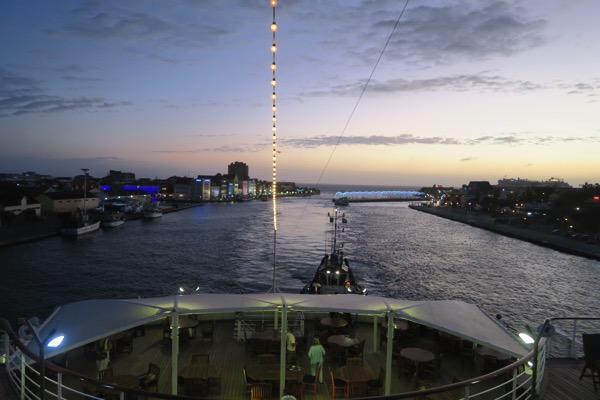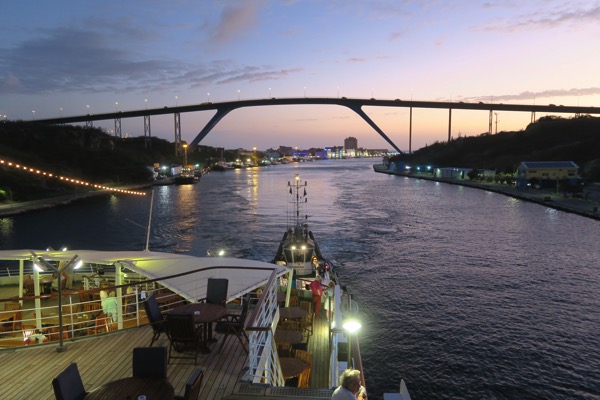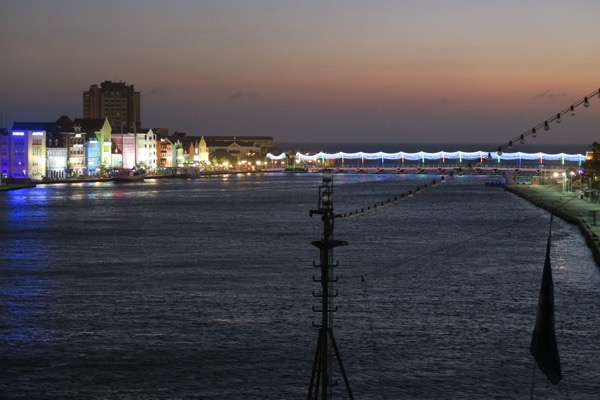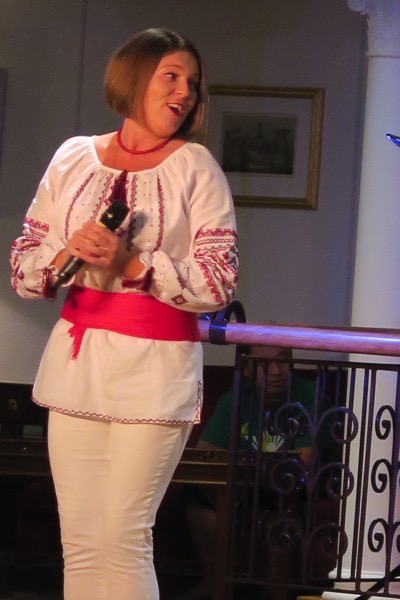
Google Maps: Curaçao, a Dutch Caribbean island, is known for its beaches tucked into coves and its expansive coral reefs rich with marine life. The capital, Willemstad, has pastel-colored colonial architecture, floating Queen Emma Bridge and the sand-floored, 17th-century Mikvé Israel-Emanuel Synagogue. It’s also a gateway to western beaches like Blue Bay, where scuba divers can access a vertical coral wall from the shore.
Currency: Netherlands Antillean guilder
Continent: North America
Arriving in Curaçao
Technically we arrived here on yesterday evening (Day 9) because it was only a short cruise from Bonnaire but nothing happens on the evening we arrived so we have a full day here, departure being scheduled for 21:30. Of all of the places we have been to so far, arriving here last night was the most exciting, picturesque and welcoming.

For a long time we stayed still outside of what we assumed was the cruise port because we could see one of the giants moored there. But after a long wait, we turned 80 degrees to starboard (note the nautical familiarity here) and headed towards the large bridge you can see in the photograph above.

The entrance to Willemstad hides one of the best natural harbours in the Caribbean. We are now sailing directly towards the mouth of the narrow river shown in the map above which leads to the large body of water in the middle of the picture. However, there is a small bridge with lots of lights on it and pedestrians walking over it quite clearly going across the water at the mouth of the river.

Then seemingly by magic, as we are steaming towards it (albeit quite slowly), it moves out of the way and we pass through what we can now see is a bridge on Pontoons with an engine at one end to move the bridge to one side.

We now very slowly steaming down the river through the middle of town

(this is a copy of the radar plot showing where we were intending to go

and this one shows where we are)

with a large Tug attached to our stern.


As we pass through the town, the pontoon bridge starts to move back across the river.

Having passed under the high vehicle bridge,

we are now heading directly for the Refinery but the tug then goes into reverse, stops us, turns us 180 degrees and we head back into town having done a U-turn in front of the refinery.


By the time we are approaching our berth on the Otrabanda side of town, the pontoon bridge is back in place. This is a perfect demonstration of one of the major advantages of the Minerva, namely that it is small enough to get into the ports which the large cruise vessels cannot. We are moored in the town centre, they are moored at the Cruise Port some distance outside.
A very, very, impressive arrival.
In the morning we are able to easily see the town asleep
and the bridge, its control room and the pontoons.
Discover Curaçao
Visits to three of Curaçao’s major attractions feature on a tour, which also presents an interesting look at this Dutch Island’s countryside and the city of Willemstad. A scenic drive past salt flats and flamingos leads to the spectacular Hato Caves. The dramatic collection of grottoes filled with stalactites, stalagmites and crystal clear pools have been centuries in the making. Enjoy a short stroll along the Petroglyph Indian Trail at the foot of the caves past an ancient shelter for slave shepherds and see 1,500-year old religious scenes that have been carved into the rock walls. In Otrabanda visit the Curaçao Museum where contemporary art is on show along with an exhibition of life on the island during the mid-19th century. Otrabanda and Punda are the two sides of St Ana Bay. Enjoy magnificent views over both before crossing Queen Juliana Bridge spanning the natural harbour. Continue to Chobolobo to sample the Blue Curaçao Liqueur and see how it is made before driving through Punda in the heart of Willemstad.
Much of the city is on the Unesco World Heritage List. To quote: "The Historic Area of Willemstad is an example of a colonial trading and administrative settlement…….”.The listing is well worth reading (here) and we found it reassuring to note that it comments on a couple of terrible developments in the town including a hotel which stands out like a sore thumb.
We start our tour by driving towards the Curaçao Museum through the suburbs of Otrabanda (the name given to the western side of the city). There is a general policy of trying to retain the original houses of the city, to maintain them and to paint them in one of the original colours.
The original houses were made from coral because (then) it was a cheap and easy to obtain local stone. However, it is very fragile and requires frequent re-rendering (covering with sand and cement) in order to survive the elements.
This church is undergoing the final stages of restoration but looks absolutely striking and in keeping with its surroundings.
The Curaçao Museum is our first port of call
and having been a Military Hospital, it is now part museum, part art gallery, part historical record.
The large galleries are immediately recognisable as being
hospital ward shaped,
(this is a rather nice Mahogany Crib on display)
and the verandas easily evoke an image of rows of convalescent beds in the open air.
This is the Kitchen and it is not decorated in a modern art style, it was said that the large
white dotes confused flies and hence they left the kitchen alone. We have never come across this style or explanation anywhere else in the world!
The Museum houses a 47 Bell Clarion which was brought here in 1951. It is not played now because the vibrations from the bells are damaging the structure of the building and they are afraid the Clarion Tower might collapse.
There is also a Clarion Trainer for those who wish to learn to play this slightly esoteric instrument.
Amongst the works in the Art side of the Museum are
this rather striking Stained Glass Map,
a painting showing the Pontoon Bridge in around 1940 when it carried vehicle traffic as well as pedestrians, and
Labor Panels 1953 by Charles Eyck who lived in Curaçao from 1950 to 1953 when this painting was done.
Hato Caves
On the way to the caves we passed some Pink Flamingos
the closest we had been to them so far.
The Hato Caves are not as spectacular as many we have been to but interesting never-the-less. To get to them you climb up a fairly steep path and then walk into the caves and follow a descending route which takes you and your guide through the caves to a lower exit.
The caves were lived in by escaping slaves and signs of their presence is obvious.
Photographs are only allowed in one of the lesser interesting parts.
Outside we aw our first Iguana close up
and nearby some Indian Petroglyphs but no explanation of their meaning was available or offered.
Curaçao - the Liqueur
Most people only know the word Curaçao with respect to the liqueur and we of course had to go to where it is made and try the smallest of samples (for the first time ever).
The factory looks just like a warehouse and in fact may be just that since we saw no evidence of it being made there.
The shop sells a variety of colours of Curaçao and the only new piece of information which I can provide is that genuine Curaçao comes in round bottles
such as this shape. Apparently there are numerous counterfeit versions available in bottles of various shapes but not circular - a shape which is trademarked to protect it. We saw some other shape bottles in the town during the afternoon.
Independent Willemstad
A full day in port enables you to spend some time exploring Curaçao’s capital Willemstad at your own leisure. The town centre can be reached via shuttle that will be in operation.
We were moored so close to the town that no shuttle was required. The view of the Punda side of town was very pleasing (although the hotel sticks out like a sore thumb - planners ! )
and we decided to walk across the bridge which was originally built in 1888 and restored in 2006.
As we walked, we heard a bell starting to ring but took no notice of it because bells are always ringing. However as we approached the far side we noticed the bridge was beginning to move and a gap was appearing !
We jumped the gap and this is what others had to do as well unless the wanted to be marooned on the wrong side.
and eventually a boat goes through
When a small boat goes through, the bridge only opens up a little bit for a few minutes. When a large boat goes through, obviously the bridge is open for far longer and there is a
ferry service which runs during these periods.
There are some wonderful original buildings in the town
Curaçao Synagogue

The Mikvé Israel-Emanuel Synagogue is Curaçao is a place which many visitors go
because for a fee of $10US, you can visit the oldest synagogue in the Americas. It is an impressive building and very peaceful.
One of the reasons that the floor inside is covered with sand is said to be to remind those who use the Synagogue of the 40 years their forebears wandered through the wilderness deserts of the Middle East.
Attached is a small museum containing numerous articles about the synagogue, the history of very members of the congregation and a slight attempt to educate those of other faiths about the Jewish faith.
Shopping
We always like to see market stalls and what is on sale because you learn a lot about the town and the people who live there.
The market stalls we saw sold a large variety of fresh vegetables and fruit,
most we could recognise but some we could not.
And just to show there were items for the less discerning client,
Dushi means (politely) Sweetie or Babe. Colloquially it means a lot more - why would you want to have that on your rear I wonder? I suspect Mrs Harvey might not want a pair!
When we got back to the boat, it was receiving a not very urgent paint job.
This is typical of the care the crew take of the ship and they were painting bits we could not see needing painting - obviously we do not look close enough.
We left at night and the bridge opened to allow us to leave

and we sailed out past the town


and a large cruise ship

we which were glad we were not on.
Crew Review
That evening the crew put on their regular review for this cruise.

This (as I am sure you will recognise) is a Philippine dance called Maglalatik (aka The Coconut Dance).


Our Cabin Stewardess (Maryna Ivashchenko) appeared singing the Ukrainian song “In Our Ukraine” - what a surprise and we thought she was very good (both as a singer and as a Cabin Stewardess)

and this was a Ukrainian Dance called “Hopak” which according to the web, is the National Dance of Ukraine. A very good day and an unusual evening.
No comments:
Post a Comment